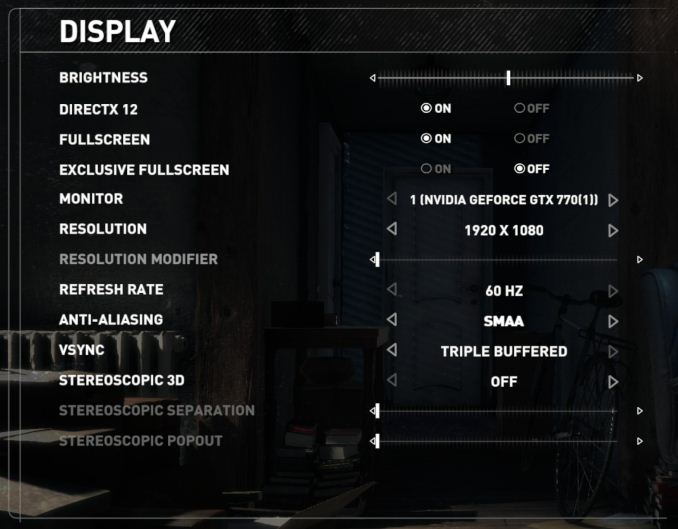Retesting AMD Ryzen Threadripper’s Game Mode: Halving Cores for More Performance
by Ian Cutress on August 17, 2017 12:01 PM ESTRise of the Tomb Raider (1080p, 4K)
One of the newest games in the gaming benchmark suite is Rise of the Tomb Raider (RoTR), developed by Crystal Dynamics, and the sequel to the popular Tomb Raider which was loved for its automated benchmark mode. But don’t let that fool you: the benchmark mode in RoTR is very much different this time around.
Visually, the previous Tomb Raider pushed realism to the limits with features such as TressFX, and the new RoTR goes one stage further when it comes to graphics fidelity. This leads to an interesting set of requirements in hardware: some sections of the game are typically GPU limited, whereas others with a lot of long-range physics can be CPU limited, depending on how the driver can translate the DirectX 12 workload.
Where the old game had one benchmark scene, the new game has three different scenes with different requirements: Spine of the Mountain (1-Valley), Prophet’s Tomb (2-Prophet) and Geothermal Valley (3-Mountain) - and we test all three (and yes, I need to relabel them - I got them wrong when I set up the tests). These are three scenes designed to be taken from the game, but it has been noted that scenes like 2-Prophet shown in the benchmark can be the most CPU limited elements of that entire level, and the scene shown is only a small portion of that level. Because of this, we report the results for each scene on each graphics card separately.
Graphics options for RoTR are similar to other games in this type, offering some presets or allowing the user to configure texture quality, anisotropic filter levels, shadow quality, soft shadows, occlusion, depth of field, tessellation, reflections, foliage, bloom, and features like PureHair which updates on TressFX in the previous game.
Again, we test at 1920x1080 and 4K using our native 4K displays. At 1080p we run the High preset, while at 4K we use the Medium preset which still takes a sizable hit in frame rate.
It is worth noting that RoTR is a little different to our other benchmarks in that it keeps its graphics settings in the registry rather than a standard ini file, and unlike the previous TR game the benchmark cannot be called from the command-line. Nonetheless we scripted around these issues to automate the benchmark four times and parse the results. From the frame time data, we report the averages, 99th percentiles, and our time under analysis.
All of our benchmark results can also be found in our benchmark engine, Bench.
#1 Geothermal Valley Spine of the Mountain
MSI GTX 1080 Gaming 8G Performance

1080p



4K



ASUS GTX 1060 Strix 6G Performance

1080p



4K



Sapphire Nitro R9 Fury 4G Performance

1080p



4K



Sapphire Nitro RX 480 8G Performance

1080p



4K



#2 Prophet’s Tomb
MSI GTX 1080 Gaming 8G Performance

1080p



4K



ASUS GTX 1060 Strix 6G Performance

1080p



4K



Sapphire Nitro R9 Fury 4G Performance

1080p



4K



Sapphire Nitro RX 480 8G Performance

1080p



4K



#3 Spine of the Mountain Geothermal Valley
MSI GTX 1080 Gaming 8G Performance

1080p



4K



ASUS GTX 1060 Strix 6G Performance

1080p



4K



Sapphire Nitro R9 Fury 4G Performance

1080p



4K



Sapphire Nitro RX 480 8G Performance

1080p



4K



















104 Comments
View All Comments
Gigaplex - Thursday, August 17, 2017 - link
How is Windows supposed to know when a specific app will run better with SMT enabled/disabled, NUMA, or even settings like SLI/Crossfire and PCIe lane distribution between peripheral cards? If your answer is app profiles based on benchmark testing, there's no way Microsoft will do that for all the near infinite configurations of hardware against all the Windows software out there. They've cut back on their own testing and fired most of their testing team. It's mostly customer beta testing instead.peevee - Friday, August 18, 2017 - link
Windows does not know whether it is a critical gaming thread or not. Setting thread affinity is not a rocket science - unless you are some Java "programmer".Spoelie - Friday, August 18, 2017 - link
And anyone not writing directly in assembly should be shot on sight, right?peevee - Friday, August 18, 2017 - link
You don't need to write in assembly to set thread affinities.Glock24 - Thursday, August 17, 2017 - link
Seems like the 1800X is a better all around CPU. If you really need and can use more than 8C/16T then get TR.For mixed workloads of gaming and productivity the 1800X or any of the smaller siblings is a better choice.
msroadkill612 - Friday, August 18, 2017 - link
The decision watershed is pcie3 lanes imo. Otherwise, the ryzen is a mighty advance in the mainstream sweet spot over ~6 months ago.OTH, I see lane hungry nvme ports as a boon to expanding a pcs abilities later. The premium for an 8 core TR & mobo over ryzen seems cost justifiable expandability.
Luckz - Friday, August 18, 2017 - link
It seems that the 1800X has the NVIDIA spend less time doing weird stuff.franzeal - Thursday, August 17, 2017 - link
If you're going to reference Intel in your benchmark summaries (Rocket League is one place I noticed it), either include them or don't forget to edit them out of your copy/paste job.Luckz - Friday, August 18, 2017 - link
WCCFTech-Level writing, eh.franzeal - Thursday, August 17, 2017 - link
Again, as with the original article, the description for the Dolphin render benchmarks is incorrectly stating that the results are shown in minutes.